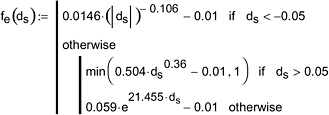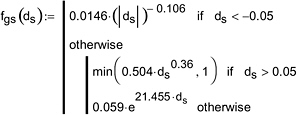C
Equivalent Yield Factors for Energy Coupling
The energy coupled to the ground from a near-surface nuclear burst is plotted in Figure 4.1 as an equivalent yield factor. The functional relationships for these results are based on a set of algorithms for energy coupling endorsed by the Defense Threat Reduction Agency that account for the effects of weapon design, geologic media, and source location1 and are summarized below.
Equivalent Yield Based on Coupled Energy

Equivalent Yield Based on Ground Shock (with air-blast effects)

where
fe = equivalent yield coupled energy
fgs = equivalent ground-shock-coupled energy
ds = the scaled depth of burst (m/kt1/3), positive into ground.
These relationships are based on numerical calculations as the only source of energy-coupling data.
NOTE
|
1. |
Defense Nuclear Agency. 1991. Effects Manual Number 1, Chapter 3, “Cratering, Ejecta, and Ground Shock,” DNA-EM-1-CH-3, Alexandria, Va., December. |


